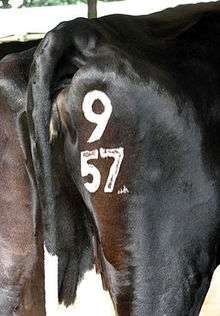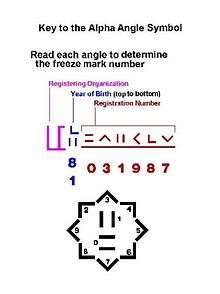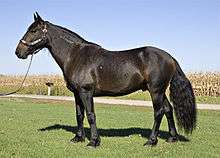Freeze brand
Freeze branding is a branding process that involves the use of liquid nitrogen or dry ice and alcohol to cool a branding iron so that the iron may then be used to alter the hair follicle of an animal to remove the pigmentation or to remove the hair altogether, depending on the color of the animal. Hair in the branded area will grow back white. On animals with white hair or no hair, the iron is left on the skin long enough so that the hair falls out and the area is balded or the skin depigmented. It is most commonly used as an identification mark for ownership.
Freeze branding is used as an alternative to the more traditional hot branding. This process involves the use of a hot iron to scar an animal's skin, which can be painful and traumatizing to the animal. Freeze branding has been gaining in popularity as a less painful way to permanently mark and identify animals. There has been debate whether freeze branding truly is less painful than hot branding, but studies conducted to compare the pain of the two methods have concluded that freeze branding is indeed less painful.[1]
Freeze branding is done by cooling the branding iron to a temperature of −78 to −196 °C (195.2 to 77.1 K; −108.4 to −320.8 °F), depending on the coolant used, and then pressing the brand to a shaved patch of skin on a pigmented animal. The area will be temporarily inflamed but will heal within a few days. The hair falls out, and after two to three months hair will be fully regrown, without pigment. The hair will continue to grow white from that point onward, so this is still permanent for animals that shed their coats. On white-haired animals, the brand is kept on longer, destroying the hair follicle altogether, and the area remains bald, and thus the brand can still be used to identify white-haired animals.[2]
Overview

Freeze branding was developed by Dr. Keith Farrell of Pullman, Washington and was first used in Sweden around 1966.[3] Since then it has become more popular for use in marking animals for identification. It is a relatively painless and easy way to permanently distinguish animals.
There are benefits and drawbacks to freeze branding as opposed to hot-iron branding. Some of the benefits are that it causes almost no permanent harm to the animal's skin, it is far less painful than a hot-iron brand, the freeze brands are highly visible no matter the time of year, and there is less blotching and distortion with a freeze brand. However freeze branding can have some problems. For example, it takes a lot longer to do properly than a hot brand and requires more specialized equipment. Also, the hair on pigmented animals must grow back in before the brand can be read and results can vary from animal to animal. If it is to be used to denote ownership, some states do not recognize it as a legal brand for designating ownership of livestock.[4]
Freeze branding changes the color of the animal's hair to white without preventing hair growth. This effect is created by killing the hair's color follicle (CF), causing the hair to grow without pigment. It therefore appears white, even though it is actually colorless. If the branding iron is applied for a longer period of time, it will also freeze the growth follicle (GF), causing the hair to stop growing entirely. On light colored animals, this is done intentionally to leave a bald patch of dark skin.[2]
Procedure
Equipment
There are a couple of pieces of equipment necessary for freeze branding. The first is a branding iron, which is made of a copper alloy because of its temperature holding capacity. The second is a set of sharp hair clippers, used to clip hair and expose bare skin. A liquid coolant, either dry ice or liquid nitrogen, will be used as well as a special container that can hold it and the irons.[5]
Alcohol is used to clean the area prior to the application of the brand. The alcohol must have a purity of 99%, or else it will not be effective because the other components will begin to freeze, turning the mixture into slush. Where multiple branding is performed, the alcohol is replaced after a time, because it automatically incorporates water from the air into itself.[2]
Process
In order to prepare for branding, a site for the brand is selected. This is important for several reasons: First, certain states and counties have different laws on legal brand placement. Another factor is the muscle underneath the skin. If part of the brand is pressed against muscle and the other part against bone, this will cause the pressure exerted on the head of the brand to be uneven. This can result in an uneven brand.[2]
The branding irons take approximately 20–30 minutes to cool, and the entire iron must be submerged, because if the brand is not evenly cooled, then the brand itself will be uneven. Liquid nitrogen cools the iron to a temperature of −196 °C (77 K; −320 °F). Dry ice can also be used, but does not get as cold, only −78 °C (195 K; −109 °F).[2]
Before branding, the site of the brand must be shaved as close to the skin as possible and is soaked with alcohol for cleaning, then that is removed and the area is re-wet with the alcohol before applying the iron.[2]
The brand is removed from the coolant and pressed to the animal's hide for a few moments before being returned to the container. The length of time the brand is applied varies based on a number of factors, including composition of the metal the irons are made from, the age of the animal, the thickness of the skin, the color or pigment to the coat, and the amount of hair in between the brand and skin.[2] If more than one animal is being branded, the clippers must be washed with liquid solvent in between the shaving of the animals. Additional time is necessary in between brands for the iron to re-cool.[4]
Example times given:
| Animal | Coolant | Application time |
|---|---|---|
| Foal | Liquid nitrogen (LN) | 6–12 sec |
| Dry ice and alcohol (DI&A) | 16–24 sec | |
| Horse | LN | 8–12 sec |
| DI&A | 20–24 sec | |
| Calf | LN | 21–24 sec |
| DI&A | 40–50 sec | |
| Cow | LN | 25–30 sec |
| DI&A | 50–60 sec |
- Darker animals require minimum amount of time suggested.[2]
Healing
Immediately after branding, an indented pattern of the brand shows for a few minutes. Then the area begins to exhibit swelling, which will subside after about five days. After a month the top layer of skin will shed and, on pigmented animals, after two months the white hair will begin to grow. At three months the process is complete and the full freeze brand is visible.[2]
Controversy
Freeze branding is often hailed as a more ethical way to denote ownership of livestock instead of the theoretically more painful hot branding. However, this claim has been challenged. Studies have been done on the subject in order to try and scientifically measure the pain of the animals during and after the branding process to allow for impartial data on the subject.
In one study, pain was measured by monitoring heart rate as well as plasma cortisol, plasma epinephrine, and hormone concentration through the collection of blood samples. An increase in any of these or vocalization by the animal was said to indicate an increase in pain. Twenty-seven calves were branded with either a hot-iron brand (H), freeze brand (F), or a "sham" brand (S), with the sham-branded cattle acting as a control group. A jugular cannula was inserted into the jugular vein in order to convey fluid and collect data; these were inserted into each calf one day before the experiment. To minimize systematic bias, researchers used blocking to separate by temperament, weight, and sex. Random assignment was called upon to denote the order and day on which the animals were branded. While being branded, ten blood samples and heart rate measurements were taken at uneven intervals between five minutes pre- and twenty minutes post-branding.[1]
This study determined that, based on the proportions and differences of pre- vs post- branding levels, mean concentrations of plasma epinephrine (EPI) at 30 seconds were higher for H calves than F and S calves. Heart rates, hormone concentrations, and EPI were increased for H calves. In terms of vocalization, one H and two F calves expressed distress during branding.[1]
Another experiment monitored the calves’ escape-avoidance reaction. The vertical movement of a calf during branding was used as an operational definition for avoidance of the brand. It was determined that H calves tried to escape the branding iron more than the F and S calves.[6]
These two experiments determined that the hot-iron branded calves experienced increased plasma epinephrine concentration, heart rate, plasma cortisol, and escape-avoidance reactions and therefore experienced more pain than the freeze branded and sham branded calves.[1][6]
Common usage

Freeze brands are used in a number of ways. For example, they are used as an indicator that an animal belongs to a herd, which are all marked with the same brand, and as a way to tag animals that will later be recaptured for research. It is typically used on cattle, horses, and dogs.
Horses

Horses are branded using both hot-iron and freeze branding. Horses are often branded using a freeze brand as a way to denote ownership. Different ranches will usually have a unique brand that they mark their horses with. Freeze brands can also be used to denote breed in general, or to identify an animal with a specific breed registry. The brand is usually located on a horse's haunches or neck. All numbers are written using the International Alpha Angle Symbol because they cannot be changed or altered in any way. This is critical because it preserves the integrity of the original brand, making the mark unchangeable and the system reliable.[3]
Since April 1978, all free-ranging mustangs and burros rounded up by the Bureau of Land Management (BLM) and the U.S. Forest Service have been identified with a freeze brand on the left hand side of their neck. Since then it has become extremely rare to find a mustang without a freeze brand.[3] The brand first denotes the registering organization, which is the US Government, as it is the BLM that brands the mustangs. This is followed by the year of birth, which is the two numbers following the registration symbol, stacked vertically, showing only the last two digits of the birth year. The last section is the registration number. This consists of six numbers that indicates the area where the animal originated.[7]
Here are some BLM registration numbers and the areas they represent:
| AZ | CA | CO | ID | MT | NV | NM | OR | UT | WY | Eastern states |
|---|---|---|---|---|---|---|---|---|---|---|
| 080001–160000 | 160001–240000 | 240001–320000 | 320001–400000 | 400001–480000 | 480001–640000 | 640001–720000 | 000000–080000 | 720001–800000 | 800001–880000 | 880001+ |
Cattle
Herds of cattle are often marked using a freeze brand to show which herd or owner they belong to. Other methods of doing this include ear tags, ear notches, ear tattoos, and electronic identification. These are often used in conjunction to freeze branding, with one being an individual marker and the other, usually the freeze brand, denoting the herd.[8]
Although it is generally accepted that freeze branding is less painful than hot-iron branding, it is still less commonly used. This is due to the fact that freeze branding is more expensive because the materials are less common and can evaporate if they are not kept properly cooled. Conversely, to heat a brand all that is required is fire. To freeze it requires either liquid nitrogen or dry ice. These can both be relatively uncommon, especially in rural areas.
Scientific tagging
Freeze branding is one of the few ways of marking an animal that meets all of William Ricker's requirements for an effective marking system. Ricker was a scientist interested in developing ways to effectively mark animals in scientific experiments so as to create an identifying system that does not unintentionally influence scientific data. His four requirements are:
- The marking should not change the animal's behavior or their ability to survive, including detection by predators;
- it shouldn't affect the animal's vulnerability to capture;
- it should allow each individual to be marked uniquely and
- it should not be temporary.[9]
Freeze branding was tested as a marking system on frogs. Previous ways of marking amphibians that were to be recaptured included tagging and mutilation. Freeze branding is an example of tagging. It has no permanent effects other than to identify individuals. Mutilation, on the other hand can particularly affect an individual's life history. Toe-clipping is commonly used, but it can affect the anuran’s motor skills and can cause weight loss. These things will all affect the mortality rate of the amphibians. Very few methods meet all of the requirements; however freeze branding is one of them.[9]
When testing freeze branding, it was used to mark frogs that were then released into the wild and later recaptured. One set of researchers used a branding iron made of copper wire, cooled by dry ice for 30 minutes. The brand was then applied to the anuran's skin for about ten seconds. The brand was then re-cooled for 20–30 seconds before being applied to a new frog. By using different numbers, orientations, and differentiating by sex, it is possible to create a number of combinations in order to mark large numbers of frogs.
The brands were all healed and readable within 24 hours, making them near immediately effective. The branded area gradually loses its pigmentation over time so that older brands are almost completely transparent, showing their long term benefit.[9]
See also
References
- Lay DC, Jr; Friend, TH; Randel, RD; Bowers, CL; Grissom, KK; Jenkins, OC (February 1992). "Behavioral and physiological effects of freeze or hot-iron branding on crossbred cattle". Journal of Animal Science. 70 (2): 330–6. doi:10.2527/1992.702330x. PMID 1548193.

- Riggs, Paul; Householder, Doug. "Operating Instruction for L&H Freeze Branders". L&H Branding Irons. L&H Branding Irons. Archived from the original on 7 January 2015. Retrieved 16 November 2014.
- "Wild Horse and Burro Freezemarks". KBR's World of Wild Horses and Burros. KBR Horse Net. Retrieved 16 November 2014.
- Torell, Ron; Riggs, Willie. "Freeze Branding Ranch Animals" (PDF). University of Nevada, Reno. University of Nevada, Reno. Retrieved 16 November 2014.
- Lalman, Dave; Bates, Frank; Apple, Ken. "Freeze Branding Cattle" (PDF). Oklahoma Cooperative Extension Service. Oklahoma State University. Retrieved 16 November 2014.
- Lay, Donald; Friend, Ted; Grissom, Ken; Bowers, Cynthia; Mal, Michael (1992). "Effects of freeze or hot-iron branding of angus calves on some physiological and behavioral indicators of stress". Applied Animal Behaviour Science. Department of Animal Science, Texas A&M University. 33 (2–3): 137–147. doi:10.1016/S0168-1591(05)80003-6.
- "How to Read a Freezemark". Bureau of Land Management. U.S. Department of the Interior. Archived from the original on 14 February 2015. Retrieved 16 November 2014.
- Parish, Jane; Rhinehart, Justin. "Freeze Branding Beef Cattle" (PDF). Mississippi State University. Extension Service Mississippi State University. Retrieved 16 November 2014.
- Daugherty, Charles H. (30 December 1976). "Freeze-branding as a technique for marking anurans". Copeia. 1976 (4): 836–838. doi:10.2307/1443482. JSTOR 1443482.